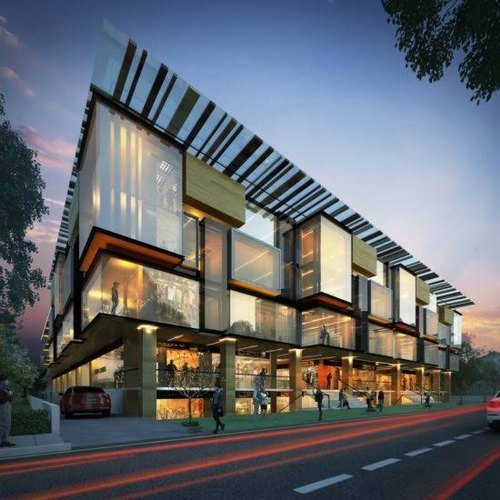Exactly How Commercial Architects Can Transform Your Company Area With Expert Layout Services
Commercial architects play a vital duty in improving organization environments. Their know-how in style can greatly boost both capability and aesthetics. By developing spaces that reflect a brand's identification, they improve functional efficiency and staff member fulfillment. Nonetheless, the impact of their work extends beyond simple appearance. Recognizing the nuances of collaboration and sustainability can result in transformative results. What details aspects make these improvements effective?
Understanding the Function of Commercial Architects
Commercial architects play an important duty fit company environments that are both practical and cosmetically pleasing. They concentrate on developing spaces tailored to the details requirements of companies, guaranteeing that every square foot is made use of successfully. These professionals integrate aspects such as spatial layout, lights, and materials to boost performance and staff member well-being. By teaming up with customers, commercial architects collect understandings into operational requirements and brand identity, equating these right into ingenious designs.Additionally, they browse complex building ordinance and zoning regulations, ensuring compliance while taking full advantage of layout capacity. Their competence encompasses sustainability practices, advertising power performance and eco-friendly products in their tasks. Through their imaginative vision and technical understanding, commercial architects not only develop enticing rooms yet also foster atmospheres that advertise cooperation and development. Inevitably, their payments greatly affect the total success and image of a company.
Benefits of Specialist Style Services

Tailoring Spaces to Your Brand Identification
Customizing areas to a brand name's identity is important for sharing its core worths and goal. Commercial architects play an essential function in enhancing an organization's visual identification via thoughtful layout selections. By straightening building components with brand principles, firms can create environments that resonate with clients and staff members alike.
Reflecting Brand Worths
Just how can a properly designed room embody a firm's core values? Commercial architects play a vital role fit settings that reverberate with a brand name's identity. By integrating aspects such as color pattern, materials, and formats, they create rooms that reflect the significance of the organization. For instance, a tech firm might select open layouts and contemporary furnishings to communicate advancement and collaboration, while a high-end brand might pick classy coatings and intimate rooms to stimulate exclusivity and class. Thoughtful design not just enhances performance however additionally cultivates a strong link between staff members, clients, and the brand. Inevitably, a well-crafted atmosphere offers as a tangible representation of a company's mission and vision, enhancing its values at every touchpoint.
Enhancing Aesthetic Identity
What aspects can efficiently boost a brand's visual identity within a commercial space? Commercial architects play a pivotal role in incorporating layout features that resonate with a business's ethos. Color design, typography, and materials can be strategically chosen to mirror brand name values while making sure visual charm. In addition, incorporating logo designs and brand imagery into the architecture can produce a cohesive visual narrative. Lights layout can better enhance the environment, assisting client assumptions and experiences (commercial architects). Layout and furniture options should line up with the brand's individuality, whether it's modern-day, typical, or cutting-edge. Inevitably, a properly designed business area not just draws in consumers but additionally reinforces brand name acknowledgment, developing a long-term impact that cultivates loyalty and involvement
Enhancing Performance and Efficiency
Enhancing functionality and efficiency in business areas includes optimizing room use and designing operations that simplify procedures. Architects focus on creating formats that lessen thrown away area while promoting smooth adjustments between tasks. This approach not only enhances performance however also adds to a much more cohesive workplace.
Maximizing Room Utilization
Effective space use is a critical element in commercial design, where the layout must stabilize looks with performance (commercial architects). Architects utilize various approaches to maximize offered square footage while making sure that each area serves a distinctive purpose. By evaluating workflow, web traffic patterns, and customer needs, architects can produce formats that enhance both employee performance and client experience. Multi-functional areas, adaptable furniture arrangements, and enhanced storage space solutions are important elements in attaining this objective. In addition, incorporating natural light and open areas cultivates a much more welcoming atmosphere, further boosting the utility of the atmosphere. Inevitably, reliable space use not just improves functional performance but also contributes positively to the overall brand name picture, making it a crucial factor to consider in commercial design
Structured Operations Design
Just next how can a well-designed process transform an industrial space right into a hub of efficiency? Streamlined process layout concentrates on maximizing the physical format and functional processes within an organization environment. By strategically organizing workstations, meeting locations, and sources, architects can get rid of unnecessary movement and boost cooperation. This thoughtful layout decreases distractions and helps with communication, permitting workers to concentrate on their tasks more successfully. In enhancement, integrating innovation right into the workflow can further automate procedures, minimizing time invested in regular tasks. Because of this, organizations experience enhanced employee spirits and raised outcome, creating a vibrant environment that cultivates advancement. Ultimately, spending in streamlined operations design not just enhances functionality yet additionally places an industrial area for sustainable development and success.
Promoting Collaboration With Design
Modern offices frequently focus on individual performance, the design of industrial spaces increasingly emphasizes collaboration as a key vehicle driver of innovation and group cohesion. Architects play a vital role in creating atmospheres that promote interaction amongst employees. Open formats, multifunctional rooms, and strategically placed public locations urge spontaneous conversations and conceptualizing sessions.Incorporating aspects such as movable furnishings and versatile conference rooms allows groups to reconfigure rooms based on their collective needs. Additionally, integrating technology, like interactive white boards and video clip conferencing devices, boosts the ability to communicate efficiently, despite click site location.Natural light and biophilic style aspects also contribute to a more welcoming ambience, advertising comfort and well-being, which are important for productive teamwork. By concentrating on these elements, industrial architects can create vibrant atmospheres that not only enhance cooperation yet also drive overall business success.
Lasting Style Practices in Commercial Design

Instance Studies: Successful Improvements by Commercial Architects
The implementation of sustainable layout practices has not only reshaped the method to commercial style however has actually also resulted in remarkable improvements in various service areas. One notable case is the redesign of a technology company's head office, where architects integrated all-natural light and environment-friendly walls, causing enhanced staff member well-being and efficiency. This change lowered energy expenses by 30% and enhanced the business's public image.In an additional instance, a retail shop underwent a full overhaul, using redeemed materials and energy-efficient systems. This not only brought in eco-conscious consumers yet likewise increased foot website traffic by 25%. A third instance involved a company workplace that embraced an open-plan layout with flexible offices, cultivating collaboration among teams. The architects' emphasis on creating a vibrant and adaptable setting substantially boosted worker fulfillment. These situation research studies exhibit how industrial architects can produce impactful rooms that align with service goals and sustainability efforts.
Often Asked Concerns
Just How Much Do Commercial Style Provider Typically Price?
The price of business architecture solutions varies widely, commonly ranging from $100 to $250 per hour. Variables affecting rates include job complexity, location, and the designer's experience, making it important for services to obtain thorough estimates.
What Kinds Of Companies Benefit Most From Commercial Architects?
Different organizations, including retail, friendliness, and company offices, substantially benefit from business architects. These specialists improve performance, appearances, and brand name identification, ensuring spaces are maximized for customer interaction and staff member productivity, inevitably promoting company growth.
The length of time Does a Commercial Style Project Normally Take?
The timeline for a business design task normally ranges from numerous weeks to numerous months. Variables affecting duration consist of project complexity, governing authorizations, and cooperation among stakeholders, every one of which can influence general completion time.
Can I Employ a Commercial Architect for Renovations Only?
Yes, working with a business architect for improvements is feasible. Many architects concentrate on improvement tasks, giving proficiency in optimizing existing areas while sticking to regulations and boosting performance, aesthetics, and overall value of business atmosphere.
What Credentials Should I Try to find in an Industrial Designer?
